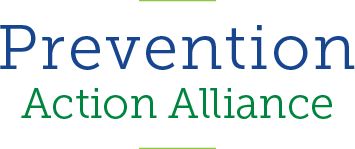
Drug misuse comes with serious health problems, including an increased risk of addiction. According to the National Institute on Drug Abuse, long-term use of drugs can lead to heart or lung disease, cancer, mental health issues, HIV/AIDS, hepatitis, and other diseases while short-term use can cause heart attack, stroke, psychosis, overdose, and death.
The good news is that drug misuse is preventable. Prevention addresses the root causes behind drug use, protects our families and young people, and stops addiction before it starts.
What is Prevention?
According to the Substance Abuse and Mental Health Services Administration, prevention helps people develop the knowledge, attitudes, and skills they need to make good choices or change harmful behaviors.
Prevention is one part of the continuum of behavioral health. The other parts are promotion, treatment, and recovery. All are critical elements of a robust behavioral healthcare system, but each one has its own unique role. Promotion supports positive behaviors. Prevention reduces the risk of behavioral health issues. Treatment cares for someone with a diagnosed substance use disorder or mental health illness. And recovery helps people live productive lives after treatment.
Inside the continuum of behavioral health, prevention is universal, selective, or indicated. Universal prevention targets the entire population, such as all students attending a specific school. Selective prevention targets subpopulations that are at increased risk, such as all students of low socioeconomic standing at a specific school. And indicated prevention helps students who are vulnerable to a substance use disorder. Indicated prevention may, for instance, aim to help students who have shown signs of substance abuse but don’t have a diagnosable disorder.
It’s important to know that prevention is different from harm reduction. Harm reduction seeks to minimize or remove the consequences of drug misuse while prevention aims to stop drug misuse from occurring. Harm reduction is not prevention.
Factors of Prevention
Like many diseases, no two addictions are alike. While everyone is susceptible to addiction, there are certain risk and protective factors that influence a person’s likelihood of becoming addicted. These factors can each be further divided into three more categories—individual, environmental, and genetic.
Individual factors include whether a parent misused drugs, a history of trauma, and a lack of social attachment. Environmental factors include the availability of drugs in the area, exposure to violence, and community poverty. Genetic factors include a family history of substance use disorder and can account for about half of a person’s likelihood of developing an addiction. For each risk factor, there is a corresponding protective factor.
According to NIDA, risk and protective factors include:
| Risk Factors | Protective Factors |
| Aggressive behavior in childhood | Good self-control |
| Lack of parental supervision | Parental monitoring and support |
| Drug experimentation | Positive relationship |
| Availability of drugs at school | Anti-drug policies at school |
| Community poverty | Neighborhood resources |
Strategies for Prevention
There are six strategies for primary prevention activities, according to SAMHSA’s Center for Substance Abuse Prevention. They are:
- Information dissemination – provides awareness and knowledge of the nature and extent of drug misuse and its effects.
- Education – communicates to improve the life and social skills of participants. This is different from information dissemination because the teacher and participants interact with each other.
- Alternatives – provides activities that don’t include drugs, including alcohol and tobacco, in hopes that participants will have their needs met without resorting to drugs.
- Environmental – establishes or changes community standards, codes, and attitudes to influence the misuse of drugs in a community.
- Community-based process – enhances the ability of the community to provide prevention and treatment services.
- Problem identification and referral – identifies people who have initiated drug misuse to assess if their behavior can be changed through education. As a prevention activity, this does not refer people to treatment but provides intervention before treatment is needed.
A Word on Scare Tactics
Scare tactics emphasize the worst dangers of drug use to create fear and anxiety in the hopes that fear alone will prevent or stop risky behaviors. Scare tactics seem intuitive to us as adults. After all, we intentionally avoid situations that frighten us or make us worry that we’ll be harmed.
Accordingly, a lot of prevention has been built around making drug use seem as frightening and harmful as possible. Mock car crashes, gruesome scenes, images of people before and after drug addiction, graphic depictions of death and drug use, auditorium speakers who share how drug use ruined their lives, videos of dead, drunk drivers being scraped off the road, and other frightening messages are all scare tactics. Unfortunately, despite all the creativity, energy, and money spent on these tactics, research has consistently shown that scare tactics don’t work in preventing substance misuse.
Prevention and Adolescents
Adolescence is a time of transition, and transitions increase the risk of drug misuse. When a teenager moves homes, suffers a divorce in the family, or changes schools, they are more likely to seek out drugs as a coping tool. They also face greater stressors than they did in elementary school, and they are more likely to engage in risky behaviors, like misusing drugs than adults.
The harmful effects of drug misuse are also greater for adolescents. Their brains are still developing, and that makes teens’ brains more likely to be disrupted by drug use. In fact, the earlier someone misuses drugs, the more likely they are to become addicted to them. Of those who have an addiction, or substance use disorder, 90% of them began using drugs under the age of 18.
Because of these risks, prevention is the best strategy for addressing addiction, according to NIDA. There are many evidence-based programs that have been proven to improve the protective factors and to minimize risk factors for drug use in adolescents.
If you’re concerned about you or someone else, get help at findtreatment.gov.
